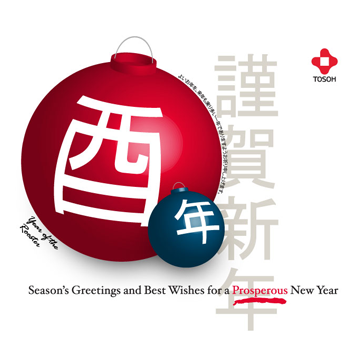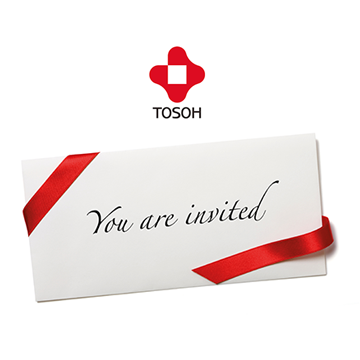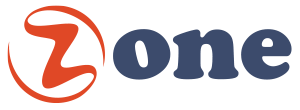Type: Enterprise (Multi-Languages)
Purpose: Various Occasions

Client Case Study: TOSOH Corporation
TOSOH Corporation, understanding the importance of fostering and strengthening relationships with its stakeholders, which predominantly include clients and customers, decided to adopt a more personalized and meaningful approach. They equipped their sales team with three distinct modules intended to enhance customer interaction. The first was a system for sending online greeting cards. This platform allowed team members to send personalized eCards on various occasions such as New Year, Chinese New Year, and other significant holidays. They also introduced modules for sending customized invite and thank-you eCards. This initiative showcased TOSOH’s commitment to maintaining robust relationships with their contacts while adding a personal touch to their professional interactions.
Portal Facts
Number of Users: 1,750+
Number of Admins: 3
eCards Delivered: 32,000+
View Rate: 79%
Design Examples



Challenge
For a project like this one implemented by TOSOH Corporation, several challenges might emerge. Here are a few possible challenges, including those related to user data privacy and admin maintenance:
1. User Data Privacy: Ensuring the security and privacy of user data is a top priority. This might be challenging, given the scale of data being processed, including personal contact information and content of communication. The system must comply with international data protection regulations. Mitigating the risk of data breaches, hacking, and unauthorized access to sensitive information would require robust data encryption and secure access protocols.
2. Admin Maintenance: Administering and maintaining the system could be demanding. Ensuring that the system is consistently up-to-date and capable of handling high volumes of user requests is crucial. This requires regular updates, security patches, and preventive maintenance to avoid downtime and maintain smooth operations.
3. Scalability: As the user base grows, the system must be scalable to manage increased traffic and data without compromising performance or security.
4. User Experience: Designing an intuitive user interface that is easy for sales teams to use and customize for different occasions and client preferences can be challenging. The system must be user-friendly, engaging, and adaptive to different devices and screen sizes.
5. Training: Training the sales team to effectively use these new modules could be a significant task. The team would need to understand not only how to use the system but also the importance of adhering to data privacy regulations.
6. Regulatory Compliance: Depending on the jurisdictions TOSOH operates in, the e-cards system must comply with various digital communication and marketing laws. Failure to comply could result in penalties.
Meeting these challenges would require careful planning, execution, and ongoing management of the system. It’s critical for TOSOH to collaborate with IT, legal, and operational teams to successfully implement this project while maintaining a strong emphasis on data privacy and system maintenance.
Solution
To provide a solution for this project, the TOSOH Design Team will be involved in creating and supplying the necessary artwork. The following steps outline how this process will unfold:
1. Requirements Gathering: Initially, the TOSOH Design Team will work closely with the project team to understand the specific requirements for the artwork. These may include specific themes, color schemes, sizes, and styles to match the project needs.
2. Design Concept Development: Based on the gathered requirements, the TOSOH Design Team will create a variety of design concepts. These concepts will be sketched out and presented to the project team for initial feedback. This ensures the design is on the right track and adheres to the project’s vision.
3. Artwork Creation: After receiving feedback and approval of the chosen concept, the team will proceed with creating the final artwork. This will involve rendering the concept in the chosen medium, whether digital or traditional, ensuring the quality and detail are of a high standard.
4. Review and Iteration: Upon completion of the initial artwork, the team will present it to the project leads for review. Any feedback received will be implemented through iterative design, refining the artwork until it meets the project’s expectations and standards.
5. Final Approval and Handover: Once the artwork has passed the review and iteration stage, the final piece will be presented for final approval. Upon acceptance, the TOSOH Design Team will prepare the artwork for handover, ensuring it’s in the appropriate format and resolution for its intended use.
6. Post-Handover Support: Even after the artwork has been handed over, the TOSOH Design Team will provide ongoing support to ensure its successful integration into the project. This includes troubleshooting any issues that may arise and providing minor revisions if necessary.
By following these steps, the TOSOH Design Team will be able to effectively provide the necessary artwork for this project, ensuring it’s of high quality and aligns perfectly with the project’s goals and vision.
Critical Factors
For a project that involves multi-language portal development, there are several critical factors that need to be taken into account to ensure success:
1. Language Localization: Localization is not just about translation. It also includes adapting the interface and content according to the cultural context of the target language. It’s crucial to have native or highly proficient speakers of the target languages involved in the localization process.
2. Internationalization: Before localization can occur, the software needs to be designed in a way that makes it easy to adapt for different languages and regions. This process is known as internationalization and includes considerations like supporting right-to-left languages and different date and number formats.
3. Responsive Design: With the diversity of devices available worldwide, the portal needs to have a responsive design that provides a good user experience regardless of the user’s device. This includes compatibility with different operating systems, browsers, and screen sizes.
4. Scalability: As the number of users and languages supported increases, the portal needs to be able to handle the increased load without degrading performance. This involves considerations in both the software and hardware infrastructure.
5. Usability: The interface needs to be user-friendly, intuitive, and easy to navigate for users of all the supported languages. User testing with speakers of the target languages is crucial to ensure this.
6. Security: With users possibly entering sensitive information into the portal, it’s critical to ensure that the data is stored and transmitted securely. This includes practices like encryption, secure coding practices, and regular security audits.
7. Maintenance and Updates: Language preferences and web technologies evolve over time. Regular maintenance and updates to both the language support and the technology stack are crucial to keep the portal relevant and secure.
8. Legal and Regulatory Compliance: Different countries have different laws and regulations regarding data privacy, accessibility, and other aspects of web portals. Compliance with these laws for all the target regions is a must to avoid legal issues.
9. Customer Support: Providing multilingual customer support can significantly enhance the user experience and increase user satisfaction. Therefore, planning for multilingual support is an important aspect of multi-language portal development.
By considering and addressing these factors, a successful multi-language portal can be developed that meets the needs of its diverse user base.
Process
Creating a multilingual portal is a complex process that requires careful planning and execution. Below is an outline of the step-by-step process:
1. Requirements Gathering: Identify the specific needs of the portal. This includes the number of languages it needs to support, the target audience, and the specific functionalities it needs to offer.
2. Planning: Based on the gathered requirements, create a detailed project plan outlining the tasks, timeline, resources, and budget.
3. Design: Design the user interface of the portal, focusing on its usability and accessibility for a global audience. This includes considering different cultural contexts, user habits, and device usage.
4. Internationalization: Develop the portal in a way that makes it easy to adapt for different languages and regions. This means preparing the code and structure to accommodate translations, different date and number formats, and any other region-specific features.
5. Localization: Translate and adapt the portal’s content for each target language. Ensure that the language is culturally appropriate and contextually accurate.
6. Development: Develop the portal based on the designs and localized content. Make sure it’s responsive and scalable, able to handle a high number of users, and compatible with various devices and browsers.
7. Testing: Conduct thorough testing on various aspects like functionality, compatibility, performance, and security. Test the portal in all the supported languages to ensure the localization is accurate and effective.
8. Deployment: After successful testing, deploy the portal on the live environment. Monitor it closely for any issues during the initial launch period.
9. Maintenance and Updates: Regularly update and maintain the portal to keep up with changing user needs, technology updates, and to add more languages as required.
This process will ensure the successful development of a multilingual portal that meets the needs of users across various regions and languages. It’s important to keep in mind that user feedback should be taken into consideration at all stages of the process to ensure the portal is user-friendly and meets the needs of its diverse user base.
Results
Here are some indicators of successful results for a multilingual portal development project:
1. User Engagement: There is a significant increase in user engagement on the portal, indicating that users find the portal useful and easy to navigate. The bounce rate decreases while the average time spent on the site increases.
2. User Feedback: Users provide positive feedback regarding the usability and accessibility of the portal. Feedback indicates that the portal is intuitive, easy to navigate, and effectively localized.
3. Customer Support Queries: There is a decrease in customer support queries related to usability or language issues, indicating that users are able to use the portal effectively without much assistance.
4. User Base: The user base expands, especially in the regions targeted by the localization. There is an increase in the number of users from different linguistic backgrounds.
5. Performance Metrics: The portal performs well under high traffic, indicating that it’s scalable and can handle the increase in users. There are no major issues or downtime.
6. Security: There are no major security incidents or breaches, indicating that the security measures implemented are effective.
7. Compliance: The portal meets all relevant legal and regulatory requirements in the regions it operates, avoiding any legal complications.
8. Business Metrics: The portal meets or exceeds the key business metrics set at the beginning of the project. This could include metrics related to revenue, customer acquisition, or customer retention.
9. On-Time and On-Budget: The project is completed within the set timeline and budget, showing effective project management and resource utilization.
The achievement of these results would indicate a successful outcome for the multilingual portal development project, demonstrating the effectiveness of the design and implementation, and showing the portal’s ability to cater to a diverse user base.





